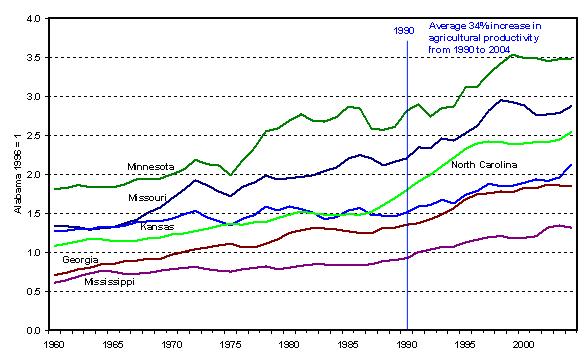Gawadne uses the development of agriculture in the United States as a prototype of what should be done.
The process by which such an agricultural extension agent can communicate with a farmer is quite efficient -- an expert communicating with an informed practitioner often by telephone. The impact of the precise answer to an important question for a 150 acre farm may be worth quite a lot of money.
Compare that to what happens in developing nations, in which farms may be very small, often an acre or less, the farmers much less educated and connected than in the United States, served by a less educated extension worker who has less backup from the research and extension service of his government. No wonder it takes decades to bring agricultural productivity up to global standards for the poorest nations.
Gawadne is clearly right that there is a fruitful analogy between the success in the 20th century of the U.S. Government's role in improving agricultural productivity and the potential for success of a U.S. Government role in improving health productivity in the 21st century.
At t the start of the twentieth century, another indispensable but unmanageably costly sector was strangling the country: agriculture. In 1900, more than forty per cent of a family’s income went to paying for food. At the same time, farming was hugely labor-intensive, tying up almost half the American workforce. We were, partly as a result, still a poor nation. Only by improving the productivity of farming could we raise our standard of living and emerge as an industrial power. We had to reduce food costs, so that families could spend money on other goods, and resources could flow to other economic sectors. And we had to make farming less labor-dependent, so that more of the population could enter non-farming occupations and support economic growth and development.Land grant colleges had been started during the Civil War under President Lincoln and eventually their agricultural field stations could develop improved techniques and adapt improved techniques to local circumstances as well as train agricultural experts. In 1914 Congress established the USDA agricultural extension service.
By 1920, there were seven thousand federal extension agents, working in almost every county in the nation, and by 1930 they had set up more than seven hundred and fifty thousand demonstration farms.......Gawadne goes on to describe his interview with a USDA extension agent who serves 660 farms in Ohio, with an average size of a hundred and fifty acres. The agent has a Bachelors and Masters degree in agronomy, and is supported by the USDA state and national expertise. The farmers he serves are themselves highly educated and highly connected by global standards.
The department invested heavily in providing timely data to farmers, so that they could make more rational planting decisions. It ran the country’s weather-forecasting system. And its statistics service adopted crop-reporting systems from Europe that allowed it to provide independent crop forecasts—forecasts that, among other things, dramatically reduced speculation bubbles........
The U.S.D.A. established an information-broadcasting service. A hundred and seventeen commercial and forty-six military radio stations carried crop reports; printed reports were distributed to fifteen million farmers a year. It also introduced a grading system for food—meat, eggs, dairy products, and fresh fruits and vegetables—to flag and discourage substandard quality.......
The government never took over agriculture, but the government didn’t leave it alone, either. It shaped a feedback loop of experiment and learning and encouragement for farmers across the country. The results were beyond what anyone could have imagined. Productivity went way up, outpacing that of other Western countries. Prices fell by half. By 1930, food absorbed just twenty-four per cent of family spending and twenty per cent of the workforce. Today, food accounts for just eight per cent of household income and two per cent of the labor force. It is produced on no more land than was devoted to it a century ago, and with far greater variety and abundance than ever before in history.
The process by which such an agricultural extension agent can communicate with a farmer is quite efficient -- an expert communicating with an informed practitioner often by telephone. The impact of the precise answer to an important question for a 150 acre farm may be worth quite a lot of money.
Compare that to what happens in developing nations, in which farms may be very small, often an acre or less, the farmers much less educated and connected than in the United States, served by a less educated extension worker who has less backup from the research and extension service of his government. No wonder it takes decades to bring agricultural productivity up to global standards for the poorest nations.
Gawadne is clearly right that there is a fruitful analogy between the success in the 20th century of the U.S. Government's role in improving agricultural productivity and the potential for success of a U.S. Government role in improving health productivity in the 21st century.

No comments:
Post a Comment